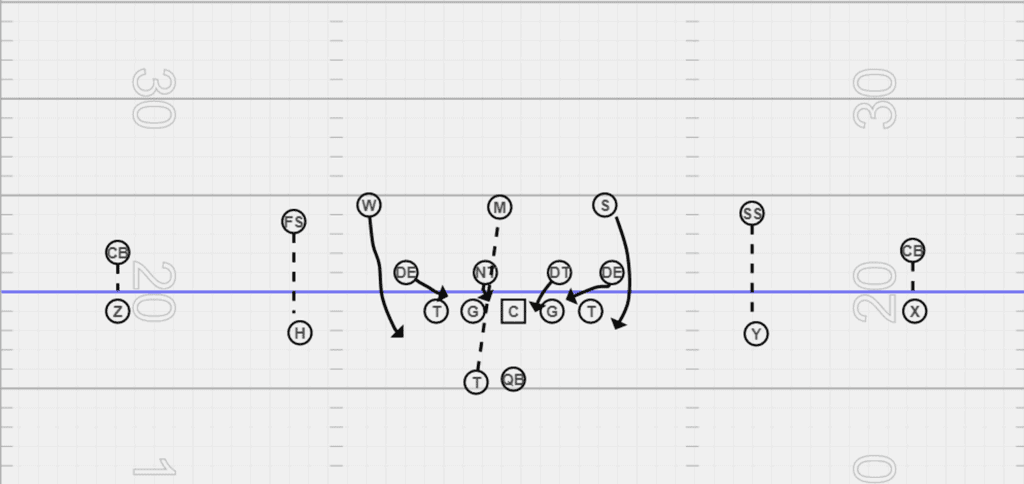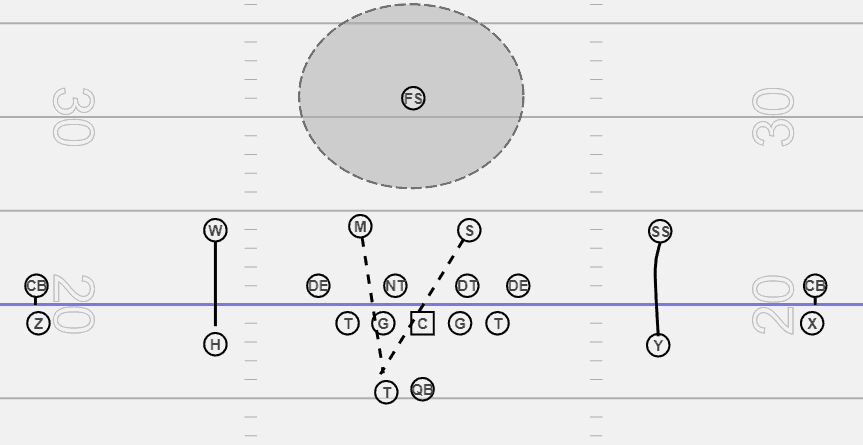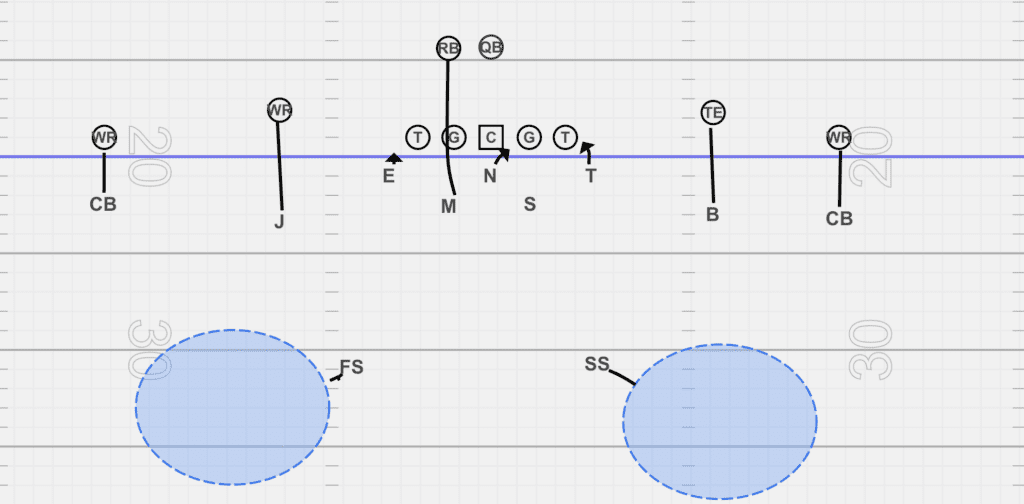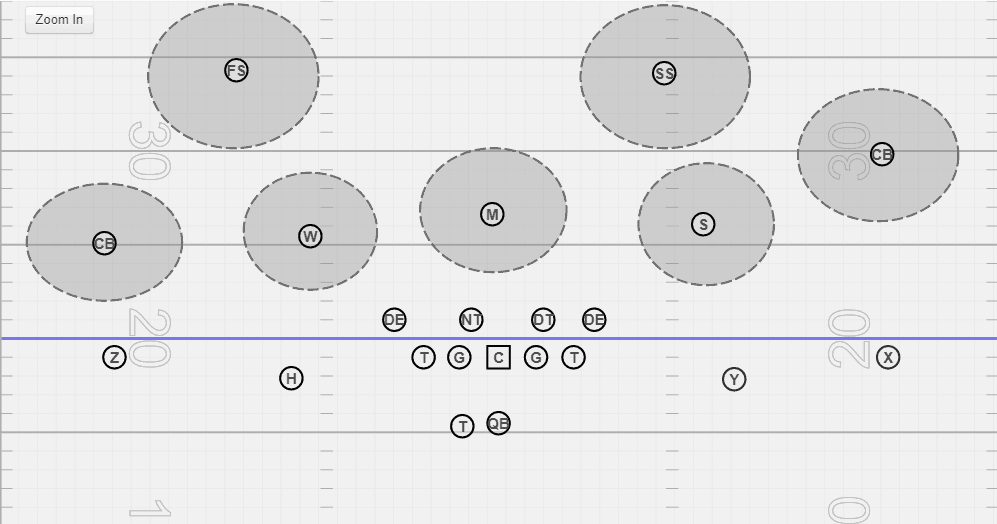Zone coverage and man coverage are essential in today’s game of football. Offensive coaches are finding innovative ways to spread the ball around the field. The key is to play sound pass coverage. Zone coverage and man coverage differ from one another.
Zone coverage is when defensive players cover a zone or area of the field to protect against the offense’s passing attack. Man coverage is when a defensive player lines up in front of a wide receiver and mirrors their every move.
Let’s learn the different types of zone coverage and how coaches implement them to stop passing offenses.
Man Coverage In Football
We’re going to highlight three different types of man coverage. Teams that play man coverage will often couple it with a blitz of some sort.
If the defense isn’t blitzing, then they will have help from either one or two safeties.
Here are the most common types of man coverage in football:
- Cover 0
- Cover 1
- Cover 2 Man
Cover 0
Deep Defenders: 0

The cover 0 defense is often called behind a blitz (a 6 man pressure). Teams will rush 6 defenders and cover the 5 eligible receivers man to man. We often have seen a heavy dose of press man coverage coupled with cover 0.
Teams do this to muddle up the wide receivers and get to the quarterback as soon as possible.
Cover 1
Deep Defenders: 1

Cover 1 is similar to cover 0, although instead of bringing a blitz (6-man pressure), the defense will bring a dog (5-man pressure).
Defenses can also double team wide receivers with cover 1, as they have an extra defender (when running a 4-man front).
Learn more about Cover 1 here.
Cover 2 Man
Deep Defenders: 2

Cover 2 man is a hybrid between man and zone coverage. 5 defenders will be in man to man coverage, while 2 safeties will cover the deep half of the field.
This coverage is often run in deep situations where the defense knows the offense will throw the football.
Learn How To Watch Film Properly…
Uncover your opponent’s offensive and defensive tendencies so you can easily build a game plan.
Inside You’ll Find:
- Strategies to pick apart defenses
- How to identify player weaknesses
- How to save time in your weekly breakdowns
Zone Coverage In Football
In football, there are primarily 4 types of zone coverages.
These zone coverage schemes can be adjusted by the coach, but they are often played the same by most defenses at every level of football.
The 4 types of zone coverage are:
- Cover 2
- Cover 3
- Cover 4
- Cover 6
We like to teach zone coverages by the number of deep defenders. If the coverage is cover 2, there are 2 deep defenders, and so on with all of the other coverage numbers.
Zone defenses often rely on the quick reaction time of their defenders. They need to be able to react to the quarterback as fast as possible, and cover receivers who go into their zones.
These zones are played by defensive backs as well as linebackers.
Cover 2

Deep Defenders: 2
Cover 2 is the first zone coverage in our series of zone coverages. Whereas cover 1 has one deep defender with man coverage underneath, cover 2 has two deep safeties, and all the underneath defenders are playing zone.
Cover 2 is useful to defend against teams that like to throw crossing routes or short routes. It does, however, put a tremendous amount of stress on the deep defenders. Ultimately the 2 deep defenders are responsible for splitting the field in half. Each defender must cover 26.6 yards.
The strong safety and the free safety are responsible for one half of the field each. They cover any and all deep routes that go into their deep zone.
Learn more about cover 2 here.
Cover 3

Deep Defenders: 3
Cover 3 is the most balanced zone coverage as it has 3 deep defenders and 4 underneath defenders. The deep defenders are now splitting the field into thirds. Adding a third person to the mix now cuts the field to cover 17.76 Yards for each deep defender to cover.
Underneath, the field is often split into 2 different zones on each side of the football:
- Hook/Curl
- Flats
Learn more about cover 3 here.
Cover 4

Deep Defenders: 4
Also known as umbrella coverage, cover 4 has 4 deep defenders which are splitting the field into 13.325 yards.
Cover 4’s weakness, however, is the underneath coverage.
Like how we broke down the cover 3 deep defenders, cover 4 relies on 3 underneath defenders to cover 17.76 yards each.
Typically the underneath defenders will cover 3 specific areas:
- True Middle of the field
- Hook/Curl
- Flats
Coaches, however, have gotten creative over the years by showing a cover 4, influencing flat routes, and using the corners to rob underneath routes.
Cover 6
We’ve covered the different types of man coverage; now, let’s look at a different type of zone coverage. The Cover 6 defense is another type of zone defensive scheme. It is similar to the Cover-2, Cover-3, and Cover-4 defensive looks but differs in a key way; it is not obvious what Cover-6 means. Let’s start with a picture of the coverage:

Cover 6 is a split field coverage where half of the defense is playing cover 4, and the other half is playing cover 2. It’s a way to offset the coverage for the offense to confuse them.
Deep Coverage
We can see that it carries elements of both a Cover-4 and a Cover-2 scheme. On one side of the field, we see the Cornerback dropping back to take 1/4 of the deep field with the safety on that side taking the next 1/4. This leaves the other safety left the responsibility of handling the other 1/2 of the deep field.
It is reasonable to expect that the cornerback who drops deep is doing so on the same side in which there is a nickel, or slot, corner. This is because this defensive back is more adept at covering the boundary zone than a linebacker is.
Underneath Coverage
With one cornerback dropping deep downfield to take a 1/4, the underneath coverage has to rotate to fill this gap. Since we now know the corner that rolls deep is typically on the same side as the nickel corner, we assume that the nickel corner will move to the boundary.
The remaining linebacker core and another cornerback essentially drop into a zone where they are. As shown in the image above, this results in about each player owning 1/4 of the underneath field. The responsibilities underneath look very similar to a Cover-3 defense.
Underneath zones are important because they are usually where the offense throws crossing routes to stretch the defense.
Strengths & Weaknesses Of Zone Defense
The strengths and weaknesses come from who is on the field at the time this defense is called. A nickel package vs. a 4-3 (or even a dime package) will dictate the speed and coverage skills of the players on the field.
An offense could look to exploit a linebacker (as opposed to a corner) by dropping all the way to the boundary. On the flip side, the offense may look to run the ball toward the nickel corner side if they favor that matchup over going toward a linebacker instead.
Zone defense is prone to a play-action play. If either safety or the corner with deep 1/4 responsibility bites on a fake, it can leave a huge opening for the offense to exploit. Like any defense, Cover 6 should be used as part of a mix of looks to confuse an offense and not necessarily used as the base scheme.
According to Pro Football Focus, the Chicago Bears ran this significantly more than any other team in the NFL, with their usage topping the Rams in second place. Note that these teams only used this scheme in under 20% of their snaps.
Conclusion
Don’t stop learning here! These zone coverage schemes are important to the overall structure of any defense. If you want to learn more about football an improve your football IQ, check out our Ultimate Football Guide below.
Playing man or zone coverage is completely up to the coach. There are advantages and disadvantages to all coverages. We recommend choosing the coverage that best fits the team you’re going to play.


